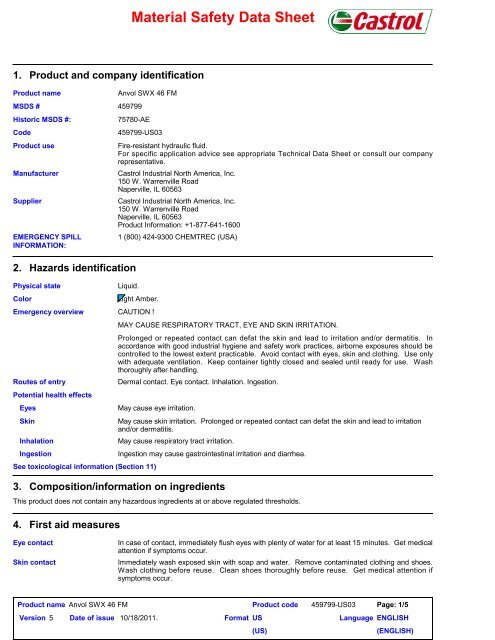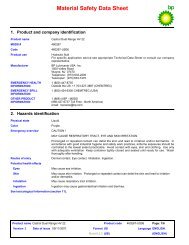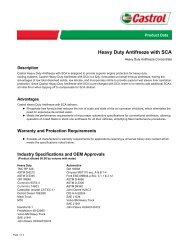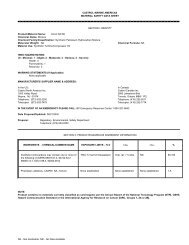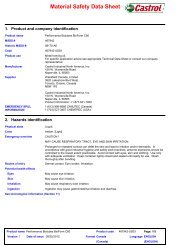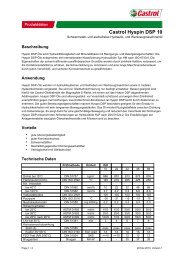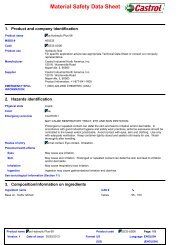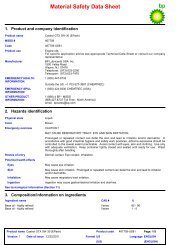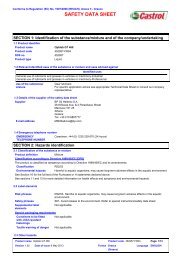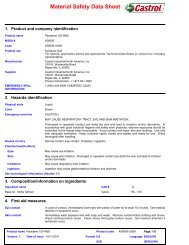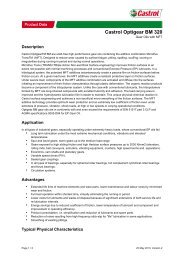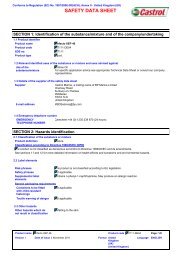(US)069654Anvol SWX 46 FM.pdf - Castrol
(US)069654Anvol SWX 46 FM.pdf - Castrol
(US)069654Anvol SWX 46 FM.pdf - Castrol
You also want an ePaper? Increase the reach of your titles
YUMPU automatically turns print PDFs into web optimized ePapers that Google loves.
Material Safety Data Sheet<br />
1. Product and company identification<br />
Product name<br />
MSDS # 459799<br />
Historic MSDS #:<br />
Code<br />
Product use<br />
Manufacturer<br />
Supplier<br />
EMERGENCY SPILL<br />
INFORMATION:<br />
Anvol <strong>SWX</strong> <strong>46</strong> <strong>FM</strong><br />
75780-AE<br />
2. Hazards identification<br />
Physical state<br />
Color<br />
459799-<strong>US</strong>03<br />
Fire-resistant hydraulic fluid.<br />
For specific application advice see appropriate Technical Data Sheet or consult our company<br />
representative.<br />
<strong>Castrol</strong> Industrial North America, Inc.<br />
150 W. Warrenville Road<br />
Naperville, IL 60563<br />
<strong>Castrol</strong> Industrial North America, Inc.<br />
150 W. Warrenville Road<br />
Naperville, IL 60563<br />
Product Information: +1-877-641-1600<br />
1 (800) 424-9300 CHEMTREC (<strong>US</strong>A)<br />
Light Amber.<br />
Emergency overview CAUTION !<br />
Routes of entry<br />
Potential health effects<br />
Eyes<br />
Skin<br />
Inhalation<br />
Ingestion<br />
Liquid.<br />
See toxicological information (Section 11)<br />
MAY CA<strong>US</strong>E RESPIRATORY TRACT, EYE AND SKIN IRRITATION.<br />
Prolonged or repeated contact can defat the skin and lead to irritation and/or dermatitis. In<br />
accordance with good industrial hygiene and safety work practices, airborne exposures should be<br />
controlled to the lowest extent practicable. Avoid contact with eyes, skin and clothing. Use only<br />
with adequate ventilation. Keep container tightly closed and sealed until ready for use. Wash<br />
thoroughly after handling.<br />
Dermal contact. Eye contact. Inhalation. Ingestion.<br />
May cause eye irritation.<br />
May cause skin irritation. Prolonged or repeated contact can defat the skin and lead to irritation<br />
and/or dermatitis.<br />
May cause respiratory tract irritation.<br />
Ingestion may cause gastrointestinal irritation and diarrhea.<br />
3. Composition/information on ingredients<br />
This product does not contain any hazardous ingredients at or above regulated thresholds.<br />
4. First aid measures<br />
Eye contact<br />
Skin contact<br />
In case of contact, immediately flush eyes with plenty of water for at least 15 minutes. Get medical<br />
attention if symptoms occur.<br />
Immediately wash exposed skin with soap and water. Remove contaminated clothing and shoes.<br />
Wash clothing before reuse. Clean shoes thoroughly before reuse. Get medical attention if<br />
symptoms occur.<br />
Product name Anvol <strong>SWX</strong> <strong>46</strong> <strong>FM</strong><br />
Product code 459799-<strong>US</strong>03<br />
Version 5 Date of issue 10/18/2011.<br />
Format <strong>US</strong><br />
Language<br />
(<strong>US</strong>)<br />
Page: 1/5<br />
ENGLISH<br />
(ENGLISH)
Inhalation<br />
Ingestion<br />
Notes to physician<br />
If inhaled, remove to fresh air. Get medical attention if symptoms occur.<br />
Do not induce vomiting unless directed to do so by medical personnel. Never give anything by<br />
mouth to an unconscious person. If potentially dangerous quantities of this material have been<br />
swallowed, call a physician immediately. Get medical attention if symptoms occur.<br />
Note: High Pressure Applications<br />
Injections through the skin resulting from contact with the product at high pressure constitute a<br />
major medical emergency. Injuries may not appear serious at first but within a few hours tissue<br />
becomes swollen, discolored and extremely painful with extensive subcutaneous necrosis.<br />
Surgical exploration should be undertaken without delay. Thorough and extensive debridement of<br />
the wound and underlying tissue is necessary to minimize tissue loss and prevent or limit<br />
permanent damage. Note that high pressure may force the product considerable distances along<br />
tissue planes.<br />
5. Fire-fighting measures<br />
Flash point<br />
Fire/explosion hazards<br />
Extinguishing media<br />
Suitable<br />
Not suitable<br />
Fire-fighting procedures<br />
Hazardous combustion<br />
products<br />
Protective clothing (fire)<br />
Open cup: 299°C (570.2°F) [Cleveland.]<br />
In a fire or if heated, a pressure increase will occur and the container may burst.<br />
Use an extinguishing agent suitable for the surrounding fire.<br />
Do not use water jet.<br />
Promptly isolate the scene by removing all persons from the vicinity of the incident if there is a fire.<br />
No action shall be taken involving any personal risk or without suitable training.<br />
Combustion products may include the following:<br />
carbon oxides (CO, CO2) (carbon monoxide, carbon dioxide)<br />
Fire-fighters should wear appropriate protective equipment and self-contained breathing apparatus<br />
(SCBA) with a full face-piece operated in positive pressure mode.<br />
6. Accidental release measures<br />
Personal precautions<br />
Environmental<br />
precautions<br />
Methods for cleaning up<br />
Large spill<br />
Small spill<br />
No action shall be taken involving any personal risk or without suitable training. Keep unnecessary<br />
and unprotected personnel from entering. Do not touch or walk through spilled material. In<br />
accordance with good industrial hygiene and safety work practices, airborne exposures should be<br />
controlled to the lowest extent practicable. Provide adequate ventilation. Wear appropriate<br />
respirator when ventilation is inadequate. Put on appropriate personal protective equipment (see<br />
Section 8).<br />
Avoid dispersal of spilled material and runoff and contact with soil, waterways, drains and sewers.<br />
Inform the relevant authorities if the product has caused environmental pollution (sewers,<br />
waterways, soil or air).<br />
Stop leak if without risk. Move containers from spill area. Approach release from upwind. Prevent<br />
entry into sewers, water courses, basements or confined areas. Wash spillages into an effluent<br />
treatment plant or proceed as follows. Contain and collect spillage with non-combustible,<br />
absorbent material e.g. sand, earth, vermiculite or diatomaceous earth and place in container for<br />
disposal according to local regulations (see section 13). Dispose of via a licensed waste disposal<br />
contractor. Contaminated absorbent material may pose the same hazard as the spilled product.<br />
Note: see section 1 for emergency contact information and section 13 for waste disposal.<br />
Stop leak if without risk. Move containers from spill area. Dilute with water and mop up if watersoluble.<br />
Alternatively, or if water-insoluble, absorb with an inert dry material and place in an<br />
appropriate waste disposal container. Dispose of via a licensed waste disposal contractor.<br />
7. Handling and storage<br />
Handling<br />
Storage<br />
Put on appropriate personal protective equipment (see Section 8). Workers should wash hands<br />
and face before eating, drinking and smoking. Do not breathe vapor or mist. Do not ingest. Avoid<br />
contact with eyes, skin and clothing. Use only with adequate ventilation. Wear appropriate<br />
respirator when ventilation is inadequate.<br />
Store in accordance with local regulations. Store away from direct sunlight in a dry, cool and wellventilated<br />
area, away from incompatible materials (see section 10). Keep container tightly closed<br />
and sealed until ready for use. Containers that have been opened must be carefully resealed and<br />
kept upright to prevent leakage. Do not store in unlabeled containers. Use appropriate<br />
containment to avoid environmental contamination.<br />
Product name Anvol <strong>SWX</strong> <strong>46</strong> <strong>FM</strong><br />
Product code 459799-<strong>US</strong>03<br />
Version 5 Date of issue 10/18/2011.<br />
Format <strong>US</strong><br />
Language<br />
(<strong>US</strong>)<br />
Page: 2/5<br />
ENGLISH<br />
(ENGLISH)
8. Exposure controls/personal protection<br />
Occupational exposure limits<br />
This product does not have any assigned OELs.<br />
Some states may enforce more stringent exposure limits.<br />
Control Measures<br />
Hygiene measures<br />
Personal protection<br />
Eyes<br />
Skin and body<br />
Respiratory<br />
Hands<br />
Use only with adequate ventilation. If user operations generate dust, fumes, gas, vapor or mist,<br />
use process enclosures, local exhaust ventilation or other engineering controls to keep worker<br />
exposure to airborne contaminants below any recommended or statutory limits.<br />
Wash hands, forearms and face thoroughly after handling chemical products, before eating,<br />
smoking and using the lavatory and at the end of the working period. Appropriate techniques<br />
should be used to remove potentially contaminated clothing. Wash contaminated clothing before<br />
reusing.<br />
Avoid contact with eyes. Safety glasses with side shields or chemical goggles.<br />
Avoid contact with skin and clothing. Wear suitable protective clothing.<br />
Use adequate ventilation. In accordance with good industrial hygiene and safety work practices,<br />
airborne exposures should be controlled to the lowest extent practicable.<br />
The correct choice of protective gloves depends upon the chemicals being handled, the conditions<br />
of work and use, and the condition of the gloves (even the best chemically resistant glove will<br />
break down after repeated chemical exposures). Most gloves provide only a short time of<br />
protection before they must be discarded and replaced. Because specific work environments and<br />
material handling practices vary, safety procedures should be developed for each intended<br />
application. Gloves should therefore be chosen in consultation with the supplier/manufacturer and<br />
with a full assessment of the working conditions.<br />
9.<br />
Physical and chemical properties<br />
Physical state<br />
Liquid.<br />
Color<br />
Light Amber.<br />
Odor<br />
Mild.<br />
Flash point<br />
Open cup: 299°C (570.2°F) [Cleveland.]<br />
Density<br />
920 kg/m 3 (0.92 g/cm 3 ) at 20°C<br />
Viscosity Kinematic: <strong>46</strong> mm 2 /s (<strong>46</strong> cSt) at 40°C<br />
Volatility<br />
< 1% (v/v)<br />
Solubility<br />
insoluble in water.<br />
LogKow<br />
>3<br />
10. Stability and reactivity<br />
Stability and reactivity<br />
Possibility of hazardous<br />
reactions<br />
Conditions to avoid<br />
Incompatibility with<br />
various substances<br />
Hazardous decomposition<br />
products<br />
Hazardous polymerization<br />
The product is stable.<br />
Under normal conditions of storage and use, hazardous reactions will not occur.<br />
Avoid all possible sources of ignition (spark or flame).<br />
Reactive or incompatible with the following materials: oxidizing materials, acids and alkalis.<br />
Under normal conditions of storage and use, hazardous decomposition products should not be<br />
produced.<br />
Under normal conditions of storage and use, hazardous polymerization will not occur.<br />
Product name Anvol <strong>SWX</strong> <strong>46</strong> <strong>FM</strong><br />
Product code 459799-<strong>US</strong>03<br />
Version 5 Date of issue 10/18/2011.<br />
Format <strong>US</strong><br />
Language<br />
(<strong>US</strong>)<br />
Page: 3/5<br />
ENGLISH<br />
(ENGLISH)
11. Toxicological information<br />
Potential chronic health effects<br />
Carcinogenicity<br />
12. Ecological information<br />
Ecotoxicity<br />
No testing has been performed by the manufacturer.<br />
13. Disposal considerations<br />
Waste information<br />
No known significant effects or critical hazards.<br />
The generation of waste should be avoided or minimized wherever possible. Significant quantities<br />
of waste product residues should not be disposed of via the foul sewer but processed in a suitable<br />
effluent treatment plant. Dispose of surplus and non-recyclable products via a licensed waste<br />
disposal contractor. Disposal of this product, solutions and any by-products should at all times<br />
comply with the requirements of environmental protection and waste disposal legislation and any<br />
regional local authority requirements. Waste packaging should be recycled. Incineration or landfill<br />
should only be considered when recycling is not feasible. This material and its container must be<br />
disposed of in a safe way. Care should be taken when handling emptied containers that have not<br />
been cleaned or rinsed out. Empty containers or liners may retain some product residues. Avoid<br />
dispersal of spilled material and runoff and contact with soil, waterways, drains and sewers.<br />
NOTE: The generator of waste has the responsibility for proper waste identification (based on characteristic(s) or listing),<br />
transportation and disposal<br />
14. Transport information<br />
Not classified as hazardous for transport (DOT, TDG, IMO/IMDG, IATA/ICAO)<br />
15. Regulatory information<br />
U.S. Federal Regulations<br />
United States inventory<br />
(TSCA 8b)<br />
All components are listed or exempted.<br />
SARA 302/304/311/312 extremely hazardous substances: No products were found.<br />
SARA 302/304 emergency planning and notification: No products were found.<br />
SARA 302/304/311/312 hazardous chemicals: No products were found.<br />
SARA 311/312 MSDS distribution - chemical inventory - hazard identification: Anvol <strong>SWX</strong><br />
<strong>46</strong> <strong>FM</strong>: Immediate (acute) health hazard<br />
SARA 313<br />
Form R - Reporting<br />
requirements<br />
Supplier notification<br />
CERCLA Sections<br />
102a/103 Hazardous<br />
Substances (40 CFR<br />
Part 302.4):<br />
State regulations<br />
Massachusetts<br />
Substances<br />
New Jersey Hazardous<br />
Substances<br />
Pennsylvania RTK<br />
Hazardous Substances<br />
California Prop. 65<br />
This product does not contain any hazardous ingredients at or above regulated thresholds.<br />
This product does not contain any hazardous ingredients at or above regulated thresholds.<br />
CERCLA: Hazardous substances.: 1-Naphthylamine: 100 lbs. (45.4 kg); 2-Naphthylamine: 10 lbs.<br />
(4.54 kg); Aniline: 5000 lbs. (2270 kg); Formaldehyde.: 100 lbs. (45.4 kg);<br />
None of the components are listed.<br />
None of the components are listed.<br />
None of the components are listed.<br />
WARNING: This product contains a chemical known to the State of California to cause cancer.<br />
1-Naphthylamine; 2-Naphthylamine; Aniline; Formaldehyde.<br />
Product name Anvol <strong>SWX</strong> <strong>46</strong> <strong>FM</strong><br />
Product code 459799-<strong>US</strong>03<br />
Version 5 Date of issue 10/18/2011.<br />
Format <strong>US</strong><br />
Language<br />
(<strong>US</strong>)<br />
Page: 4/5<br />
ENGLISH<br />
(ENGLISH)
Other regulations<br />
Canada inventory<br />
REACH Status<br />
Australia inventory (AICS)<br />
China inventory (IECSC)<br />
Japan inventory (ENCS)<br />
Korea inventory (KECI)<br />
Philippines inventory<br />
(PICCS)<br />
All components are listed or exempted.<br />
For the REACH status of this product please consult your company contact, as identified in Section<br />
1.<br />
All components are listed or exempted.<br />
All components are listed or exempted.<br />
All components are listed or exempted.<br />
All components are listed or exempted.<br />
All components are listed or exempted.<br />
16. Other information<br />
Label requirements CAUTION !<br />
MAY CA<strong>US</strong>E RESPIRATORY TRACT, EYE AND SKIN IRRITATION.<br />
HMIS® Rating :<br />
History<br />
Date of issue<br />
Date of previous issue<br />
Prepared by<br />
Notice to reader<br />
Health 1<br />
Flammability 1<br />
Physical 0<br />
Hazard<br />
Personal B<br />
protection<br />
10/18/2011.<br />
06/08/2009.<br />
Product Stewardship<br />
Indicates information that has changed from previously issued version.<br />
National Fire<br />
1<br />
Protection<br />
Fire hazard<br />
Association (U.S.A.) Health 1 0 Instability<br />
Specific hazard<br />
All reasonably practicable steps have been taken to ensure this data sheet and the health, safety and environmental information<br />
contained in it is accurate as of the date specified below. No warranty or representation, express or implied is made as to the<br />
accuracy or completeness of the data and information in this data sheet.<br />
The data and advice given apply when the product is sold for the stated application or applications. You should not use the product<br />
other than for the stated application or applications without seeking advice from BP Group.<br />
It is the user’s obligation to evaluate and use this product safely and to comply with all applicable laws and regulations. The BP<br />
Group shall not be responsible for any damage or injury resulting from use, other than the stated product use of the material, from<br />
any failure to adhere to recommendations, or from any hazards inherent in the nature of the material. Purchasers of the product for<br />
supply to a third party for use at work, have a duty to take all necessary steps to ensure that any person handling or using the<br />
product is provided with the information in this sheet. Employers have a duty to tell employees and others who may be affected of<br />
any hazards described in this sheet and of any precautions that should be taken. You can contact the BP Group to ensure that this<br />
document is the most current available. Alteration of this document is strictly prohibited.<br />
Product name Anvol <strong>SWX</strong> <strong>46</strong> <strong>FM</strong><br />
Product code 459799-<strong>US</strong>03<br />
Version 5 Date of issue 10/18/2011.<br />
Format <strong>US</strong><br />
Language<br />
(<strong>US</strong>)<br />
Page: 5/5<br />
ENGLISH<br />
(ENGLISH)


